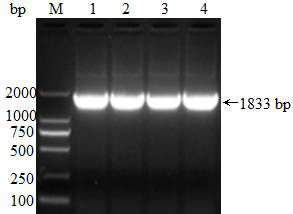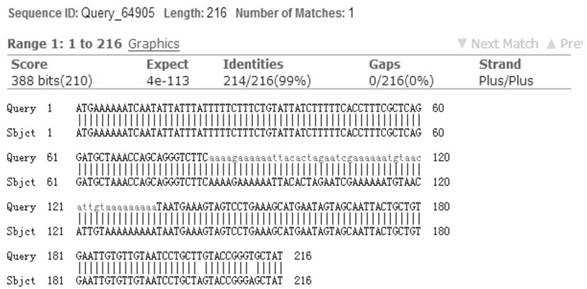Genetic engineering strain for displaying Escherichia coli enterotoxin by Saccharomycetes and application of genetic engineering strain
A technology of genetically engineered bacteria and Escherichia coli is applied in the field of genetic engineering to prevent damage to the structure of the small intestine mucosa, prevent intestinal flora imbalance in animals, and ensure safety and immune effects.
- Summary
- Abstract
- Description
- Claims
- Application Information
AI Technical Summary
Benefits of technology
Problems solved by technology
Method used
Image
Examples
Embodiment 1
[0079] Construction of ST yeast genetically engineered bacteria:
[0080] 1. Primer design
[0081] Primers were designed using Primer5 software, as shown in Table 1:
[0082] Table 1 Primer Sequence
[0083]
[0084] 2. Cloning of the target gene
[0085] The genome of the resuscitated enterotoxigenic Escherichia coli H10407 strain was extracted, and the estA and estB genes were cloned. The specific reaction system is shown in Table 2.
[0086] Table 2 PCR reaction system
[0087]
[0088] PCR reaction conditions of estA gene: 94°C, 10min; 94°C, 30s, 48°C, 30s, 72°C, 20s, 30 cycles; 72°C, 10min.
[0089] PCR reaction conditions of estB gene: 94°C, 10min; 94°C, 30s, 53°C, 30s, 72°C, 1min 45s, 30 cycles; 72°C, 10min.
[0090] PCR products were subjected to agarose gel electrophoresis, recovered and purified. The results of PCR amplification of estA gene are shown in figure 1 , lane M is the DNA molecular weight standard, lanes 1 to 4 are the PCR amplification results
Embodiment 2
[0134] To verify the effect of ST yeast genetically engineered bacteria on intestinal flora:
[0135] Select 90 SPF grade SD rats aged 4-6 weeks, half male and half male. They were randomly divided into blank control group, engineering bacteria group and yeast group, and each group was fed with normal saline, 10 7 cfu / mL engineering bacteria liquid, 10 7 cfu / mL saccharomyces cerevisiae bacterial solution 2mL / rat, once a day, continuously fed for 21 days, and then fed 10 times to each group of rats for 3 consecutive days 8 cfu / mL Escherichia coli H10407 bacterial solution 5mL / monkey, take the required fecal samples on the 7th, 14th, 21st day of feeding and 3 days after the challenge, and use the terminal restriction fragment length polymorphism (T-RFLP) , Real-time fluorescent quantitative PCR (Real-time PCR), to study the effect of yeast genetically engineered bacteria on intestinal flora OTU (microbial operable unit) and 5 kinds of iconic bacteria in the intestine
Embodiment 3
[0157] To verify the effect of ST yeast genetically engineered bacteria on the structure of intestinal villi
[0158] The duodenum, jejunum, and ileum tissues of rats were collected to make slices, and the length, width, crypt depth, and villi length / crypt depth (V / C) changes. Animal grouping is the same as in Example 2. On the 7th, 14th, 21st day of feeding and 3 days after the challenge, 6 rats in each group were taken, and about 2 cm of each sample of duodenum, jejunum and ileum were collected. The location of small intestine collection: the duodenum was collected 2-3 cm away from the pyloric opening; the jejunum was collected in the middle of the jejunum; the ileum was collected 2-3 cm away from the ileocecal opening. After sampling, each section of small intestine was stored in 4% formaldehyde solution for more than 24 hours for later use.
[0159]The results showed that, compared with the blank control group, the length of each section of intestinal villi and the V
PUM
 Login to view more
Login to view more Abstract
Description
Claims
Application Information
 Login to view more
Login to view more - R&D Engineer
- R&D Manager
- IP Professional
- Industry Leading Data Capabilities
- Powerful AI technology
- Patent DNA Extraction
Browse by: Latest US Patents, China's latest patents, Technical Efficacy Thesaurus, Application Domain, Technology Topic.
© 2024 PatSnap. All rights reserved.Legal|Privacy policy|Modern Slavery Act Transparency Statement|Sitemap



